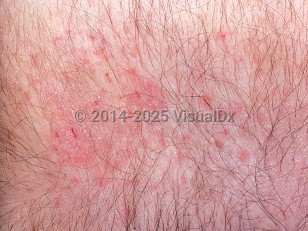Pruritus (itch) is an extremely common dermatologic complaint, especially among older individuals. Pruritus may occur as a consequence of another condition or may be a primary condition. It may be localized to one region of the body or generalized, and the location, character, and timing of symptoms vary based on the presence of an underlying cause. This summary focuses on generalized pruritus in the elderly population.
The most common cause of pruritus in the elderly is xerosis (dry skin), in which the findings are often subtle. The skin fails to retain water as it ages, and sebaceous and sweat gland activity decrease. These factors are exacerbated during the winter months when cool air and central heating cause increased evaporation of moisture. Generalized pruritus in the elderly may also be related to numerous other age-related findings such as alteration of neural pathways, increased mast cell degranulation, or increased skin sensitivity to histamine. Many medications, including narcotics, imidazoles, and B vitamins (niacin), may cause pruritus (see pruritus without rash).
Pruritus can have an enormous impact on quality of life, leading to social embarrassment, sleeplessness, and a variety of secondary skin conditions. It is important to try to determine the cause of itch and provide appropriate therapy.
Pruritus of senescence
Alerts and Notices
Important News & Links
Synopsis

Codes
ICD10CM:
L29.89 – Other pruritus
SNOMEDCT:
42570001 – Senile pruritus
L29.89 – Other pruritus
SNOMEDCT:
42570001 – Senile pruritus
Look For
Subscription Required
Diagnostic Pearls
Subscription Required
Differential Diagnosis & Pitfalls

To perform a comparison, select diagnoses from the classic differential
Subscription Required
Best Tests
Subscription Required
Management Pearls
Subscription Required
Therapy
Subscription Required
References
Subscription Required
Last Reviewed:01/14/2021
Last Updated:01/14/2021
Last Updated:01/14/2021
Pruritus of senescence

